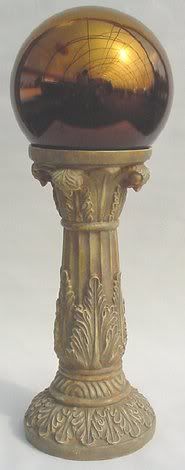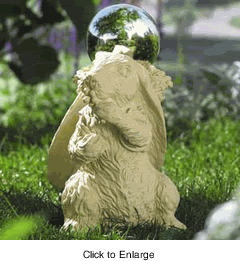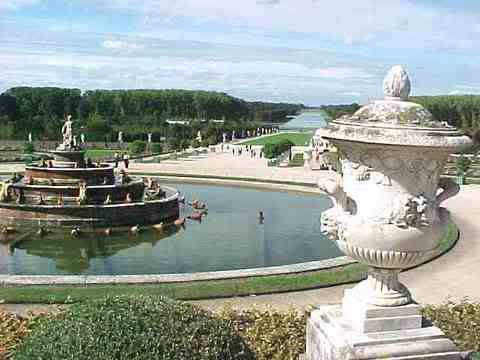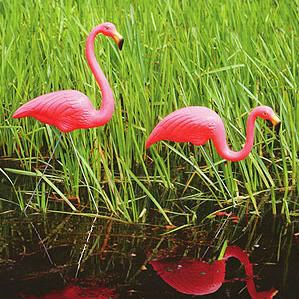Lawn Ornaments
© Thomas Wilson Shawcross 11 June 2005

photo credit: Marlene Cornman, Fayetteville, GA
“An empty yard is like an empty coffee table – it cries out for something.”
- Don Featherstone
Joy Green bought a Kodak CX7350 digital camera recently, and she has been posting photos at the Kodak EasyShare Gallery web site. Here is a photo of her garden in Auburn, California:

Note the blue gazing ball behind (and above) the sundial
It had been several years since I had seen a gazing ball, and here is a photo that has two! There is a green one to the left of the blue one. Joy writes that she has a third gazing ball, a purple one, to the left of the fountain.
The unexpected images of gazing balls, after so many years of not seeing them, brought back a flood of memories of seeing them when I was younger.
Gazing balls have a long history. The first ones were Venetian and date back to the end of the 14th century. They were hollow, iridescent glass balls and were a symbol of fertility. Mad King Ludwig II of Bavaria called them “dream balls” and decorated the path to his garden pavilion with them.
Here is some historical information I found at:
http://www.ironelegance.com/kugelhistory.htm
They have been known by many names - Gazing Globes, Rose Balls, Good Luck Balls, Victorian Balls, Witch Balls, and Garden Globes. Also called "Globes of Happiness", they have been used symbolically as wedding gifts - said to bring the bride happiness in her new home. In the 16th century Francis Bacon stated that a proper garden would have round colored balls for the sun to play upon. They gained their current widespread popularity during Victorian times; being used both indoor as well as in the garden. One interior use was in dining rooms and on sideboards. Placed in such a way, the servant could gaze discreetly into the ball and see who may need a refill without standing and staring throughout the meal.
When I was a boy, gazing balls looked like this:

The globes came in many colors, but most often they were silver, blue, or green. I guess the glass ones were susceptible to breakage, because after a while, the manufacturers started coming out with metal globes. The stainless steel model seemed to be particularly popular.
But gazing balls are just one of the many options available to the serious lawn and garden decorator.
A quick survey of web sites has revealed the following categories from which to choose:
Gazing Balls
Garden Gnomes
Garden Stones
Garden Statues
Bird Feeders
Bird Baths
Plant Stands
Sun Catchers
Rain Gauges
Garden Thermometers
Sundials
Wind Chimes
Weather Vanes
Garden Fountains
Bird Houses
Toad Houses
Garden Bells
Hummingbird Feeders
Of course, some of these categories can be combined, as in the following garden statue / gazing globe, but I think this is going too far:

Call me old-fashioned, but I like to keep my rabbit statuary separate from my gazing globe collection.
But then, I don’t have a gazing globe collection. I don’t even have a coffee table, and maybe that is why . . . I am one of those rare ascetics who doesn’t feel that an empty yard is crying out for something, other than, perhaps, a nice mowing now and then, or maybe a good watering.
I realize that I am in the minority. Many people are more than willing to spend time and money on lawn and garden decoration. One that comes to mind was Louis XIV of France, a.k.a. The Sun King. When I worked in France, I visited his palace at Versailles three times, and I was always impressed with what he was able to achieve in his back yard with only the resources of one of the most powerful countries in Europe at his disposal. I was particularly impressed with his Grand Canal, The Orangerie, the Grand Trianon, and of course the Petit Trianon was a charming touch.

Versailles: The Fountain of Latona and the Grand Canal in the distance

I am not sure who this statue is, a French Garden Gnome, probably
“But Tom,” you say, “even Louis Quatorze couldn’t afford Versailles! What am I supposed to do on my more limited budget?”
Well, you could do something like Joy Green and my Aunt Dorothy have done – put in a pleasant pool, some hummingbird feeders, a wind chime, and any other decorations that catch your fancy. You really shouldn’t be asking me – a man who does not own a coffee table.
But I can tell you what you should not do. Don’t get carried away. At the opposite extreme from Versailles are those people who just don’t know when to quit. I think we have all seen examples of this. One reads of people who put up so many Christmas decorations, for example, that their home becomes a major tourist attraction, resulting in traffic jams, angry neighbors, and power outages. When I worked in New Orleans, there was a home like that – the pride and joy of a man who owned a national fried chicken franchise and nearly every Christmas light known to man.
Then there is the matter of, how shall I phrase this, good taste. One man’s Petit Trianon is another man’s Pink Plastic Flamingo. The PPF, by the way, was invented by Don Featherstone, who sculpted the original Pink Plastic Flamingo, as well as an estimated 600 to 800 other products, including ducks, garden gnomes, penguins, and about anything else one can think of.

PPFs
Actually, there is no consensus on the Pink Plastic Flamingo. To some people, the PPF epitomizes tackiness. Others think they are hilarious.
As Don says: “I'll bet 90% of the people who buy them just really like them. They feel like I do, that an empty yard is like an empty coffee table – it cries out for something. . . And I'll tell you something about people who put out flamingos: They're friendlier than most people. Remember, they don't do it for themselves – they're doing it to entertain you.”
On the other hand, there are some people who view Don Featherstone as the Thomas Midgely, Jr. of the decorative art world. You remember Thomas Midgely, Jr. – the man who within a span of three days invented the leaded gasoline that poisoned our bloodstreams and dichlorofluoromethane -- the first of the Freon gases that are destroying our protective ozone layer?
Thomas Midgely, Jr. was not a bad man, of course. He was more like a man with good intentions for whom everything seemed to turn out poorly. Its not as if he was some evil genius scientist after all – in fact he invented leaded gasoline only after he tried adding iodine to gas. His thinking was that by adding something red to the gas, it would absorb more heat before it ignited and thereby avoid engine knocking. Well, the iodine worked, although not because it was red. Iodine was too expensive, but it showed that it was possible to prevent knocking, so Midgely started going through the Periodic Table of Elements until he found something else that would work – toxic tetraethyl lead. Who knew that distributing it throughout the land through car emissions would result in such damage? As for using freon gases in refrigeration, that seemed like a perfectly good idea at the time – the freon wasn’t toxic like lead, and it wouldn’t even burn! Who knew it would gobble up our ozone layer? Not surprisingly, Thomas Midgely, Jr. was killed by one of his own well-intentioned inventions. He developed polio at age 51 and lost the use of his legs, so he rigged up an elaborate set of pulleys to help him get in and out of bed. One day, he got tangled and strangled in the pulleys.
One can only wonder, if he had lived, what he might have done with a nice-sized lawn and garden and a generous budget.

photo credit: Marlene Cornman, Fayetteville, GA
“An empty yard is like an empty coffee table – it cries out for something.”
- Don Featherstone
Joy Green bought a Kodak CX7350 digital camera recently, and she has been posting photos at the Kodak EasyShare Gallery web site. Here is a photo of her garden in Auburn, California:

Note the blue gazing ball behind (and above) the sundial
It had been several years since I had seen a gazing ball, and here is a photo that has two! There is a green one to the left of the blue one. Joy writes that she has a third gazing ball, a purple one, to the left of the fountain.
The unexpected images of gazing balls, after so many years of not seeing them, brought back a flood of memories of seeing them when I was younger.
Gazing balls have a long history. The first ones were Venetian and date back to the end of the 14th century. They were hollow, iridescent glass balls and were a symbol of fertility. Mad King Ludwig II of Bavaria called them “dream balls” and decorated the path to his garden pavilion with them.
Here is some historical information I found at:
http://www.ironelegance.com/kugelhistory.htm
They have been known by many names - Gazing Globes, Rose Balls, Good Luck Balls, Victorian Balls, Witch Balls, and Garden Globes. Also called "Globes of Happiness", they have been used symbolically as wedding gifts - said to bring the bride happiness in her new home. In the 16th century Francis Bacon stated that a proper garden would have round colored balls for the sun to play upon. They gained their current widespread popularity during Victorian times; being used both indoor as well as in the garden. One interior use was in dining rooms and on sideboards. Placed in such a way, the servant could gaze discreetly into the ball and see who may need a refill without standing and staring throughout the meal.
When I was a boy, gazing balls looked like this:

The globes came in many colors, but most often they were silver, blue, or green. I guess the glass ones were susceptible to breakage, because after a while, the manufacturers started coming out with metal globes. The stainless steel model seemed to be particularly popular.
But gazing balls are just one of the many options available to the serious lawn and garden decorator.
A quick survey of web sites has revealed the following categories from which to choose:
Gazing Balls
Garden Gnomes
Garden Stones
Garden Statues
Bird Feeders
Bird Baths
Plant Stands
Sun Catchers
Rain Gauges
Garden Thermometers
Sundials
Wind Chimes
Weather Vanes
Garden Fountains
Bird Houses
Toad Houses
Garden Bells
Hummingbird Feeders
Of course, some of these categories can be combined, as in the following garden statue / gazing globe, but I think this is going too far:

Call me old-fashioned, but I like to keep my rabbit statuary separate from my gazing globe collection.
But then, I don’t have a gazing globe collection. I don’t even have a coffee table, and maybe that is why . . . I am one of those rare ascetics who doesn’t feel that an empty yard is crying out for something, other than, perhaps, a nice mowing now and then, or maybe a good watering.
I realize that I am in the minority. Many people are more than willing to spend time and money on lawn and garden decoration. One that comes to mind was Louis XIV of France, a.k.a. The Sun King. When I worked in France, I visited his palace at Versailles three times, and I was always impressed with what he was able to achieve in his back yard with only the resources of one of the most powerful countries in Europe at his disposal. I was particularly impressed with his Grand Canal, The Orangerie, the Grand Trianon, and of course the Petit Trianon was a charming touch.

Versailles: The Fountain of Latona and the Grand Canal in the distance

I am not sure who this statue is, a French Garden Gnome, probably
“But Tom,” you say, “even Louis Quatorze couldn’t afford Versailles! What am I supposed to do on my more limited budget?”
Well, you could do something like Joy Green and my Aunt Dorothy have done – put in a pleasant pool, some hummingbird feeders, a wind chime, and any other decorations that catch your fancy. You really shouldn’t be asking me – a man who does not own a coffee table.
But I can tell you what you should not do. Don’t get carried away. At the opposite extreme from Versailles are those people who just don’t know when to quit. I think we have all seen examples of this. One reads of people who put up so many Christmas decorations, for example, that their home becomes a major tourist attraction, resulting in traffic jams, angry neighbors, and power outages. When I worked in New Orleans, there was a home like that – the pride and joy of a man who owned a national fried chicken franchise and nearly every Christmas light known to man.
Then there is the matter of, how shall I phrase this, good taste. One man’s Petit Trianon is another man’s Pink Plastic Flamingo. The PPF, by the way, was invented by Don Featherstone, who sculpted the original Pink Plastic Flamingo, as well as an estimated 600 to 800 other products, including ducks, garden gnomes, penguins, and about anything else one can think of.

PPFs
Actually, there is no consensus on the Pink Plastic Flamingo. To some people, the PPF epitomizes tackiness. Others think they are hilarious.
As Don says: “I'll bet 90% of the people who buy them just really like them. They feel like I do, that an empty yard is like an empty coffee table – it cries out for something. . . And I'll tell you something about people who put out flamingos: They're friendlier than most people. Remember, they don't do it for themselves – they're doing it to entertain you.”
On the other hand, there are some people who view Don Featherstone as the Thomas Midgely, Jr. of the decorative art world. You remember Thomas Midgely, Jr. – the man who within a span of three days invented the leaded gasoline that poisoned our bloodstreams and dichlorofluoromethane -- the first of the Freon gases that are destroying our protective ozone layer?
Thomas Midgely, Jr. was not a bad man, of course. He was more like a man with good intentions for whom everything seemed to turn out poorly. Its not as if he was some evil genius scientist after all – in fact he invented leaded gasoline only after he tried adding iodine to gas. His thinking was that by adding something red to the gas, it would absorb more heat before it ignited and thereby avoid engine knocking. Well, the iodine worked, although not because it was red. Iodine was too expensive, but it showed that it was possible to prevent knocking, so Midgely started going through the Periodic Table of Elements until he found something else that would work – toxic tetraethyl lead. Who knew that distributing it throughout the land through car emissions would result in such damage? As for using freon gases in refrigeration, that seemed like a perfectly good idea at the time – the freon wasn’t toxic like lead, and it wouldn’t even burn! Who knew it would gobble up our ozone layer? Not surprisingly, Thomas Midgely, Jr. was killed by one of his own well-intentioned inventions. He developed polio at age 51 and lost the use of his legs, so he rigged up an elaborate set of pulleys to help him get in and out of bed. One day, he got tangled and strangled in the pulleys.
One can only wonder, if he had lived, what he might have done with a nice-sized lawn and garden and a generous budget.


2 Comments:
This comment has been removed by a blog administrator.
Interesting post about gazing balls. Looks like kids are gonna have a good time playing with them like marbles! I like wind chime in the garden, myself as I love the musical sound they make.
Post a Comment
<< Home